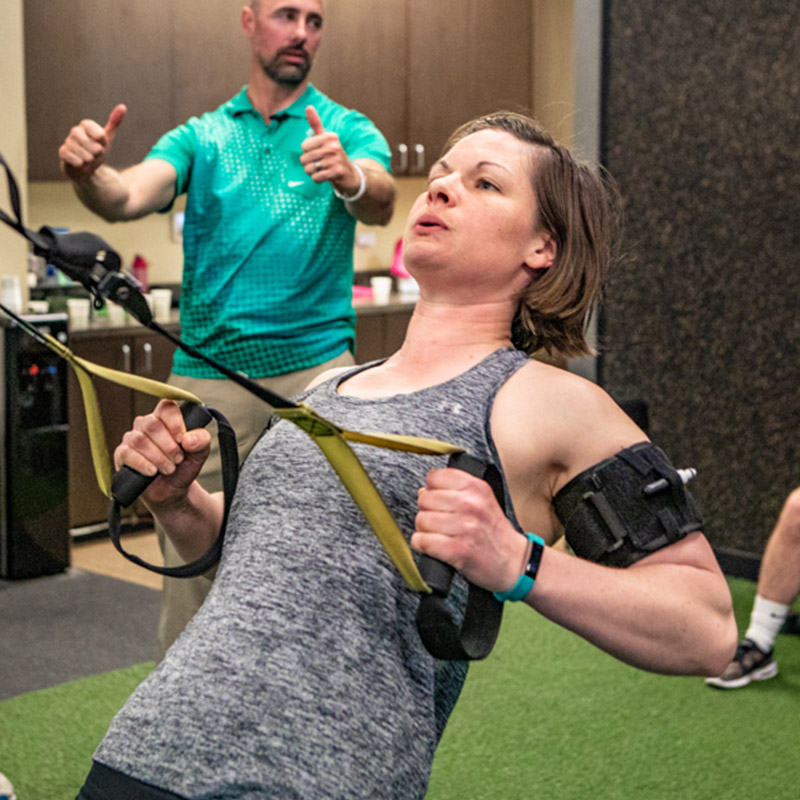For most people, following surgery or after an acute injury, weight bearing exercise on certain supporting muscles is restricted. For those whose medical team indicates that high load exercises would add too much stress to the joints and tissues that are in the healing process, Blood Flow Restriction Training (BFRT) offers the same benefits of a high load exercise or training program, using a much lower weight load.
Generally, when someone is suffering from an injury, preparing for surgery or recovering after surgery, there’s a lot of pain involved. In an effort to avoid exasperating the pain and discomfort, people tend to avoid moving the part of their body that’s hurt. When this situation is prolonged, it can lead to muscle weakness and atrophy that delays recovery and increases rehabilitation time. Utilizing BFRT, physical therapists can successfully begin guiding patients toward muscle strengthening and hypertrophy much sooner during treatment.
What is Blood Flow Restriction Training?
Blood Flow Restriction Training is a technique using FDA certified cuffs/tourniquets that safely and intermittently restricts blood flow to a specific muscle region in order to trick the body in a manner that promotes healing while avoiding detrimental stress to the joints and tissues in the region. BFRT can be used on most regions of the body to enhance and expedite recovery.
In addition to injury or post-surgical recovery, increased interest in and growing evidence of its benefits supports the use of BFRT in athletic performance training. By exercising a target muscle group while reducing the blood flow to the same area, BFRT leads to improve strength, increased muscle size, improved bone density and enhanced cardiovascular performance. This technique allows for similar improvements in strength that one would see with heavy weight training, however, uses light loads to spare surrounding joints and tissues from the mechanical stress that occurs with high intensity training.
How does Blood Flow Restriction Training Work?
When a physical therapist determines that someone is a good candidate for and will benefit from BFRT, they apply the FDA certified cuff to the leg or arm and inflate it to a predetermined pressure individualized to the patient. Utilizing doppler measurements, the PT is able to ensure arterial blood flow remains present. When blood flow is restricted, the limb is starved of oxygen. Decreasing oxygen in the muscles during exercise leads to shifting fluid to the cell wall, causing the muscle cells to swell and triggering the brain to increase muscle recruitment in the impacted region.
This process mimics high intensity workout/weight training sessions with minimal weight and joint stress by allowing for only 20-40 percent of weight to be used when compared to high load training.
When BFRT is used with light loading techniques, it can positively stimulate the release of growth hormones, which play a role in IGF-1 and aids in collagen production. This promotes injury recovery in tendon, ligament, muscle, and bone and improves strength.

Who can benefit from Blood Flow Restriction Training?
Research continually supports the safety and effectiveness of Blood Flow Restriction Training in patients from young teenagers to “geri-athletes” and has been deemed appropriate for people of all conditioning and skill levels. As musculoskeletal experts, physical therapists have the education and experience to evaluate individuals to determine whether or not BFRT is the best course of treatment for them.
Under the guided care of a trained physical therapist implementing evidence-based protocols and utilizing FDA approved cuffs, BFRT can benefit everyone from the pre- or post-surgical patient to the professional athlete interested in improving their performance and everyone in between. So, whether you are recovering from a total knee replacement, have bone density issues, strained your hamstring, or just want to up your game, our physical therapists can help and will work with you to determine if Blood Flow Restriction Training is the right choice for you to reduce your pain, recover, and reach your goals safely and quickly.
Common Conditions for Referral to BFRT:
- Pre- & post-operative
- Joint and muscle injuries
- Muscle weakness
- Ligament injuries
- Tendon injuries
- Recovery from heavy workouts
- Osteoarthritis
- Bone fractures
- Joint replacements
Benefits of BFRT:
- Increases strength & muscle size
- Prevents atrophy
- Injury rehabilitation & recovery
- Improves bone metabolism
- Improves cardiovascular fitness
Blood Flow Restriction Training (BFRT)
Blood Flow Restriction Training (BFRT) services are available at select Therapeutic Associates Physical Therapy clinics, performed by trained clinicians. Find your clinic today and talk to your physical therapist to learn more and determine if BFRT is right for you.



